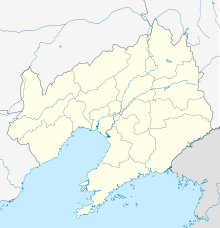Dandong Langtou Airport (IATA: DDG, ICAO: ZYDD) is an airport serving the city of Dandong, Liaoning, China.
Dandong Langtou Airport 丹东浪头机场 | |||||||||||
|---|---|---|---|---|---|---|---|---|---|---|---|
 Airport main building exterior | |||||||||||
| Summary | |||||||||||
| Airport type | Public | ||||||||||
| Operator | Civil Aviation Administration of China | ||||||||||
| Serves | Dandong, Liaoning | ||||||||||
| Location | Tangchi, Zhenxing District, Dandong, Liaoning | ||||||||||
| Opened | 21 December 1985 | ||||||||||
| Elevation AMSL | 9.1 m / 30 ft | ||||||||||
| Coordinates | 40°01′33″N 124°17′13″E / 40.025951°N 124.286906°E | ||||||||||
| Website | www | ||||||||||
| Map | |||||||||||
 | |||||||||||
| Runways | |||||||||||
| |||||||||||
| Statistics (2021) | |||||||||||
| |||||||||||
| Dandong Langtou Airport | |||||||
|---|---|---|---|---|---|---|---|
| Simplified Chinese | 丹东浪头机场 | ||||||
| Traditional Chinese | 丹東浪頭機場 | ||||||
| |||||||
History
editKorean War
editAntung Airfield was a major base for People's Liberation Army Air Force (PLAAF) and Korean People's Air Force (KPAF) fighters during the Korean War used in the defense of the supply lines across the Yalu River to the North Korean city of Sinuiju and for engaging attacking USAF aircraft in the area that became known as MiG Alley.[1]
In November 1950 reconnaissance photos showed that the previous two gravel runways had been replaced by a 6,000 feet (1,800 m) concrete runway with hard-surfaced taxiways.[1]: 245 By March 1951, the PLAAF had at least 75 MiG-15s based at Antung.[1]: 296
Civil operations
editOn April 29, 1985, Dandong Langtou Airport officially started civil operations. The first route was Shenyang - Dandong - Dalian route operated by An-24 aircraft.[2] The first renovation was carried out on June 18, 1993. After the expansion, it categorized as Category 4C airport by CAAC.[3]
On April 17, 2014, the 20,000 square metres (220,000 sq ft) new terminal was officially opened.[2] It has also expanded an apron of 20,000 square metres (220,000 sq ft) and a parking lot and oil depot of 11,000 square metres (120,000 sq ft). After the expansion, Dandong Airport increased its capacity from the current 50,000 to 2 million passengers per year.[3]
Statistics
editGraphs are unavailable due to technical issues. There is more info on Phabricator and on MediaWiki.org. |
Facilities
editThere is an international waiting hall and two domestic waiting halls, together with 3 VIP lounges. The new terminal has 4 escalators, 5 elevators and a moving walkway. There are more than 1,000 waiting seats in the 3 waiting halls, as well as drinking water areas and mobile phone charging areas. Each departure hall is equipped with a baby care room, as well as an isolation room and emergency rescue hallway. The new terminal is also equipped with two jet bridges. The 20,000 square metres (220,000 sq ft) apron can park 6 narrow-body aircraft at the same time.[2]
Airlines and destinations
edit| Airlines | Destinations |
|---|---|
| China Southern Airlines | Guangzhou,[4] Shanghai–Pudong, Shenzhen, Yangzhou[4] |
| Shanghai Airlines | Shanghai–Hongqiao, Yantai |
| Sichuan Airlines | Chengdu–Tianfu, Yantai[5] |
Gallery
edit-
Interior of main arrivals and departures hall in 2015
See also
editReferences
edit- ^ a b c Futrell, Frank (1983). The United States Air Force in Korea, 1950-1953 (PDF). Air Force History & Museums Program. pp. 222–3. ISBN 9780912799711. This article incorporates text from this source, which is in the public domain.
- ^ a b c "丹东机场_辽宁省机场管理集团公司". www.lnairport.com. Archived from the original on 2020-09-24. Retrieved 2021-01-26.
- ^ a b "丹东机场新航站楼揭开"盖头"(图)-中国民航网". www.caacnews.com.cn. 2012-11-01. Archived from the original on 2021-02-02. Retrieved 2021-01-26.
- ^ a b "民航局202324年冬春航季换季颁发、注销国内航线经营许可信息通告". Retrieved 26 October 2023.
- ^ "2023年新航季川航最新航线出炉,附国际/地区航线新消息". Retrieved 16 March 2023.
This article incorporates public domain material from the United States Air Force
